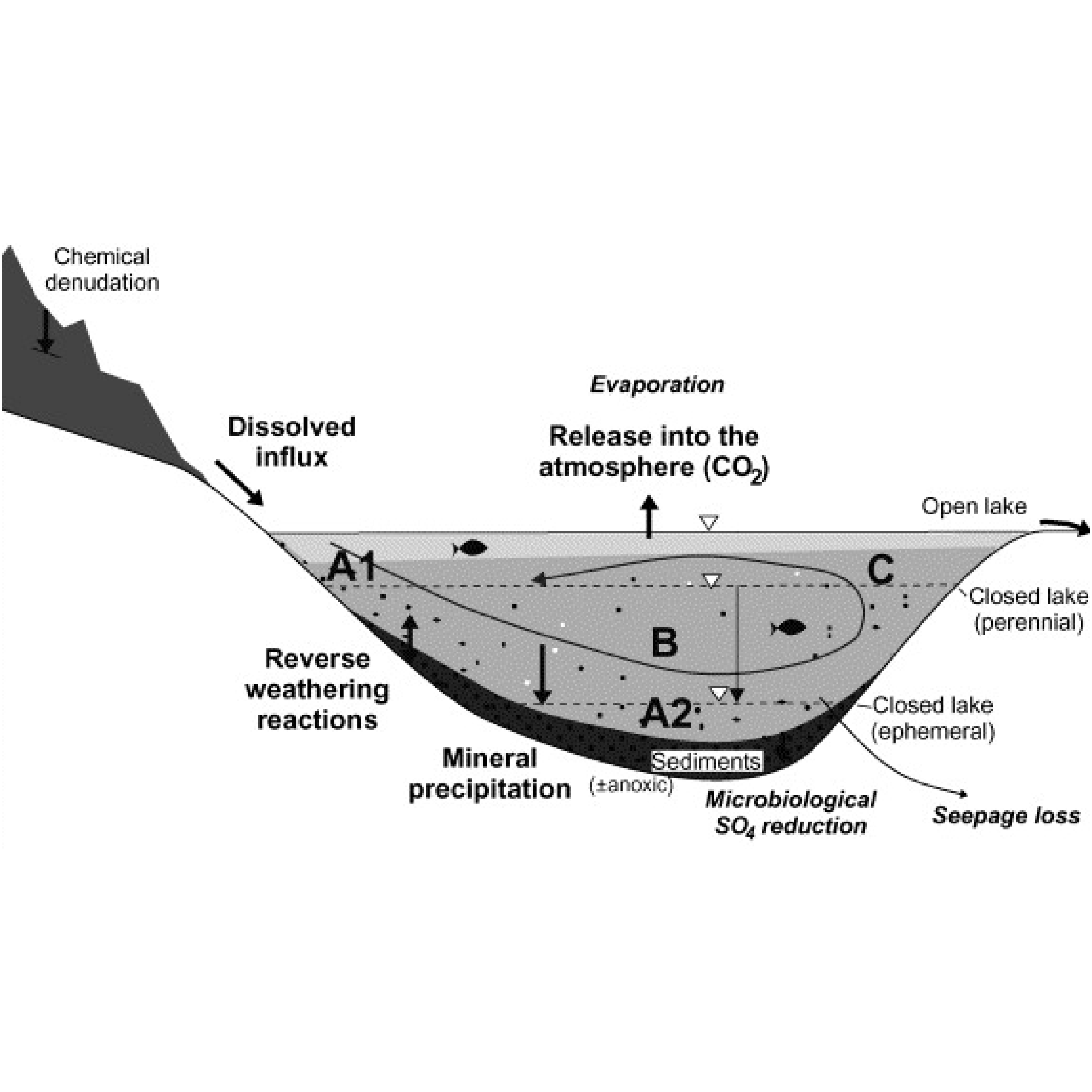
Lake Neusiedl is an example of an endorheic basin in that it retains water and allows no outflow to other external bodies of water. The lack of outflow is from the basin’s floor dropping more rapidly than water and sediments can accumulate. At the center of each basin, the endorheic lake, is a collection of water or sink that has no evident outlet. Lake Neusiedl is the largest in central Europe. Endorheic basins’ watersheds are often confined by natural geologic land formations, such as mountains, that cut off water egress to the ocean or a large body of water. Endorheic basins, including Lake Neusiedl, typically have to be treated to be used for drinking water since their inland water flows into dry watersheds where the water evaporates. This process leaves a high concentration of minerals that causes the lake to become more saline over time.
In humid areas, the basins tend to be marshy. These areas, such as Mexico City, have endorheic basins that are subject to substantial flooding in wet years and characterized by waterlogged soils that require draining. In areas where rainfall is higher, erosion will generally carve drainage channels or cause the water level in the terminal lake to rise until it finds an outlet. In deserts, the water inflow is low and large amounts of water is lost from solar evaporation, reducing the formation of drainage systems. In extreme cases, the basin will become arheic.
With limited precipitation but high potential evaporation, water storage is vulnerable to subtle flux perturbations, such as Lake Neusiedl, which has dried up over a 100 times . For this reason basins have been drained by humans, temporary farmed, or their natural cycle has been converted to an artificially dominated nature‐social water cycle in order to control the basins. Today, Lake Neusiedl’s water level is controlled by an artificial outflow, the Einserkanal, and a sluice in Hungary by the Austro-Hungarian water commission. Minor fluctuations of the lake's level continue to occur making the equilibrium sensitive to climate change. There has been a recent decline in enhoreic water storage which is exacerbated by global warming and human activities.
Processes controlling the geochemical evolution of closed-basin lakes.
Sources: J.P Yan, M Hinderer, and G Einsele, “Geochemical Evolution of Closed-Basin Lakes: General Model and Application to Lakes Qinghai and Turkana,” Sedimentary Geology (Elsevier, October 23, 2001), https://www.sciencedirect.com/science/article/pii/S0037073801002123.
Sources: J.P Yan, M Hinderer, and G Einsele, “Geochemical Evolution of Closed-Basin Lakes: General Model and Application to Lakes Qinghai and Turkana,” Sedimentary Geology (Elsevier, October 23, 2001), https://www.sciencedirect.com/science/article/pii/S0037073801002123.
- Mary Guiden, “World's Largest Cities Depend on Evaporated Water from Surrounding Lands,” Colorado State University (Colorado State University, March 13, 2018),
-
Patrick W. Keys, Lan Wang-Erlandsson, and Line J. Gordon, “Megacity Precipitationsheds Reveal Tele-Connected Water Security Challenges,” PLOS ONE 13, no. 3 (2018), https://doi.org/10.1371/journal.pone.0194311.
-
G. Ragette , “The Evaporation of Rain and Snowfall in the Subcloud Layer,” Physics and Chemistry of the Earth, Part B: Hydrology, Oceans and Atmosphere 24, no. 6 (1999): pp. 619-622, https://doi.org/10.1016/s1464-1909(99)00054-4.
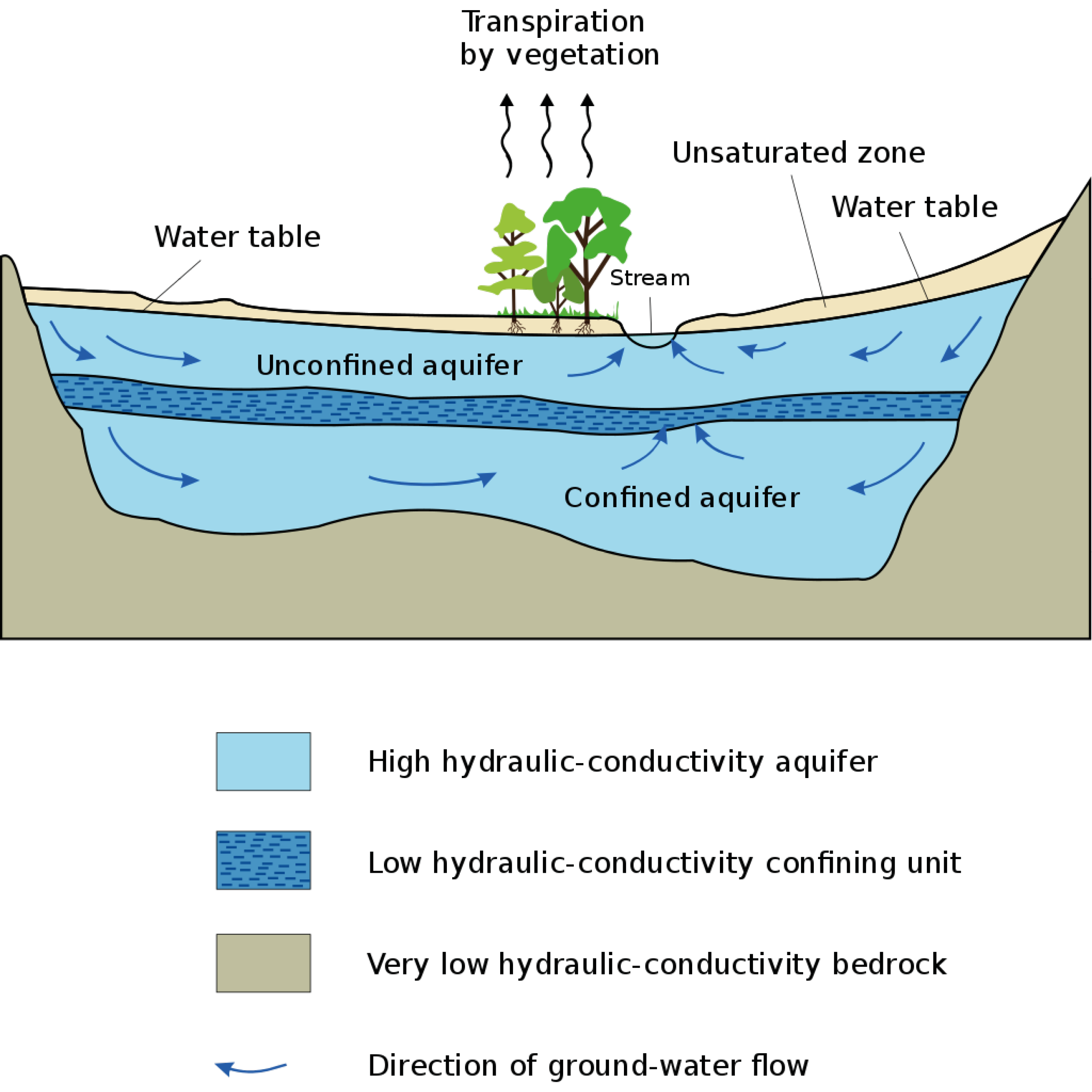
Marchfeld is an example of an aquifer in that it is a body of permeable rock can contain or transmit groundwater. The aquifer’s water movement depends on the permeability of the aquifer material. In some permeable materials, groundwater can move several meters in a day. In extreme cases, the water moves only a few centimeters in a century. Groundwater moves very slowly through relatively impermeable materials, such as clay and shale. If the groundwater is between layers of these impermeable materials, it is confined under pressure to become an artesian aquifer. An aquifer’s water, like Marchfelds, moves slowly towards lower lying places and is eventually discharged from springs, seeps into streams, or is withdrawn from the ground by wells.
97% of the earth's freshwater is stored in aquifers and groundwater is the primary source of drinking water for more than 1.5 billion people. Some of the largest cities in the developing world, such as Jakarta, Dhaka, Lima, and Mexico City, depend on aquifers for almost all their water. In rural areas, where centralized water supply systems are undeveloped, groundwater is typically the source of water.
The typical methods normally used to conceal garbage and other waste, such as landfills, septic tanks, and sewers, have become the major conduits of chemical pollution of groundwater. When aquifers are polluted, it is almost impossible to flush out contaminants from the clay layers where much of the aquifer’s water may be stored. With increases in urban population, the demand on groundwater is increasing and causing stress on the aquifers.
Many major aquifers are being drained faster than their natural rate of recharge. In some cases, areas like Marchfeld are being exploited at higher rates than previously done in the past. Marchfeld once provided water for agricultural uses but is now shifting to factory use. On average, a ton of water used in industry generates about 70 times as much profit as the same amount of water used to grow grain. Climate change has caused droughts in many aquifer areas. With the growing population and climate change, aquifers require heavy monitoring to keep the water level in balance.
97% of the earth's freshwater is stored in aquifers and groundwater is the primary source of drinking water for more than 1.5 billion people. Some of the largest cities in the developing world, such as Jakarta, Dhaka, Lima, and Mexico City, depend on aquifers for almost all their water. In rural areas, where centralized water supply systems are undeveloped, groundwater is typically the source of water.
The typical methods normally used to conceal garbage and other waste, such as landfills, septic tanks, and sewers, have become the major conduits of chemical pollution of groundwater. When aquifers are polluted, it is almost impossible to flush out contaminants from the clay layers where much of the aquifer’s water may be stored. With increases in urban population, the demand on groundwater is increasing and causing stress on the aquifers.
Many major aquifers are being drained faster than their natural rate of recharge. In some cases, areas like Marchfeld are being exploited at higher rates than previously done in the past. Marchfeld once provided water for agricultural uses but is now shifting to factory use. On average, a ton of water used in industry generates about 70 times as much profit as the same amount of water used to grow grain. Climate change has caused droughts in many aquifer areas. With the growing population and climate change, aquifers require heavy monitoring to keep the water level in balance.
Aquifer cross section.
Sources: “Aquifer,” Wikipedia (Wikimedia Foundation, April 23, 2021), https://en.wikipedia.org/wiki/Aquifer.
Sources: “Aquifer,” Wikipedia (Wikimedia Foundation, April 23, 2021), https://en.wikipedia.org/wiki/Aquifer.
- Thomas R Gatliffe, “Calibration and Reliability in Groundwater Modelling: Coping with Uncertainty,” Technometrics 44, no. 1 (2002): pp. 84-85, https://doi.org/10.1198/tech.2002.s655.
-
“Aquifers and Groundwater,” Aquifers and Groundwater, accessed March 3, 2021, https://www.usgs.gov/special-topic/water-science-school/science/aquifers-and-groundwater?qt-science_center_objects=0#qt-science_center_objects.
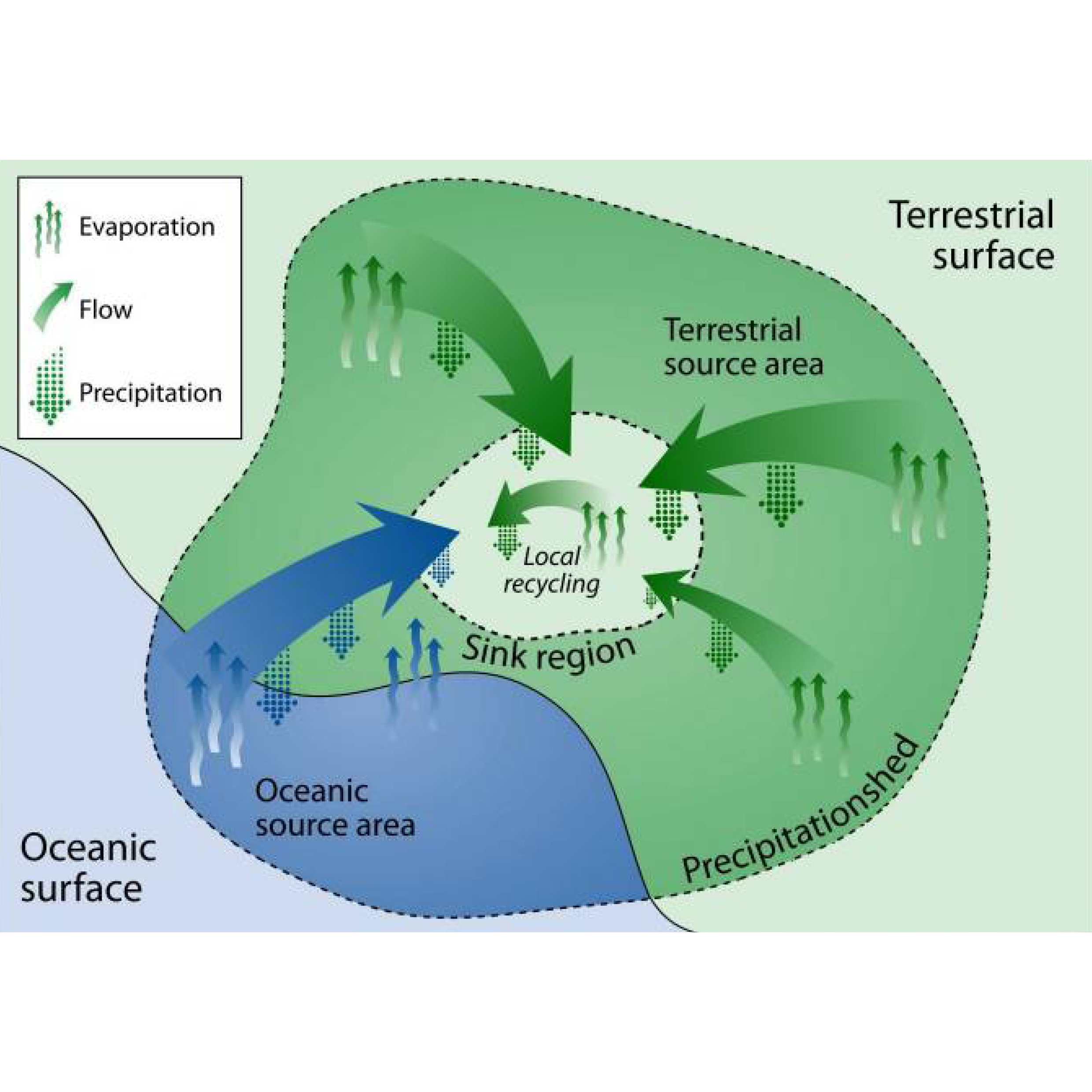
Evaporation is the process of turning from a liquid into a vapour. Natural soils in the earth are characterised by their high evaporation rates. The greatest part of stormwater is discharged by evapotranspiration. With 19 of the 29 largest cities in the world depending on evaporation from surrounding lands for more than one-third of their water supplies, evaporation is more critical to help with the increase in urban population growth. Most of these cities rely on surface water from either direct rain runoff, snow or glacial melt. For example, Mount Patscherkofel in Austria, where the water vapor is recycled back by 2.5-3% of the local precipitation of the city of Innsbruck.
Moisture recycling occurs when water evaporates from the land and rises up into the atmosphere. This moisture then flows along prevailing wind currents through the atmosphere, falling out as precipitation elsewhere. Advances in global modeling track the atmospheric moisture flowing around the planet and can identify the specific locations where moisture enters the atmosphere as evaporation, and where it falls out as precipitation. For example, Vienna’s evaporation takes place in the summer with a mean annual evaporation between 450 mm and 650 mm for the Danube River.
A precipitationshed defines a spatial boundary enclosing upwind evaporative sources of downwind precipitation and receives precipitation from an upwind source and from within itself. There can be many buffers between precipitation falling in a watershed and the water that flows into a city’s pipes, including dam storage, transport via canals, and storage in local reservoirs. For Buenos Aires, the watershed encompasses the entire La Plata basin with high amounts of moisture recycling processes occurring within the basin itself. The cities with less buffers can receive more water from moisture recycling. Changing the amount of water or when it evaporates and flows up into the atmosphere in an area can have impacts for other places and people, such as large scale deforestation for farming. Reservoirs, treatment and desalination plants are potential safeguards to mitigate climate change for cities water management.
Moisture recycling occurs when water evaporates from the land and rises up into the atmosphere. This moisture then flows along prevailing wind currents through the atmosphere, falling out as precipitation elsewhere. Advances in global modeling track the atmospheric moisture flowing around the planet and can identify the specific locations where moisture enters the atmosphere as evaporation, and where it falls out as precipitation. For example, Vienna’s evaporation takes place in the summer with a mean annual evaporation between 450 mm and 650 mm for the Danube River.
A precipitationshed defines a spatial boundary enclosing upwind evaporative sources of downwind precipitation and receives precipitation from an upwind source and from within itself. There can be many buffers between precipitation falling in a watershed and the water that flows into a city’s pipes, including dam storage, transport via canals, and storage in local reservoirs. For Buenos Aires, the watershed encompasses the entire La Plata basin with high amounts of moisture recycling processes occurring within the basin itself. The cities with less buffers can receive more water from moisture recycling. Changing the amount of water or when it evaporates and flows up into the atmosphere in an area can have impacts for other places and people, such as large scale deforestation for farming. Reservoirs, treatment and desalination plants are potential safeguards to mitigate climate change for cities water management.
Wershed of the sky that identifies the origin of precipitation falling in a given region.
Sources: Patrick W Keys, Lan Wang-Erlandsson, and Line J Gordon, “Megacity Precipitationsheds Reveal Tele-Connected Water Security Challenges,” PloS one (Public Library of Science, March 13, 2018), https://www.ncbi.nlm.nih.gov/pmc/articles/PMC5849328/.
Sources: Patrick W Keys, Lan Wang-Erlandsson, and Line J Gordon, “Megacity Precipitationsheds Reveal Tele-Connected Water Security Challenges,” PloS one (Public Library of Science, March 13, 2018), https://www.ncbi.nlm.nih.gov/pmc/articles/PMC5849328/.
- Mary Guiden, “World's Largest Cities Depend on Evaporated Water from Surrounding Lands,” Colorado State University (Colorado State University, March 13, 2018), https://source.colostate.edu/worlds-largest-cities-depend-on-evaporated-water-from-surrounding-lands/.
-
Patrick W Keys, Lan Wang-Erlandsson, and Line J Gordon, “Megacity Precipitationsheds Reveal Tele-Connected Water Security Challenges,” PloS one (Public Library of Science, March 13, 2018), https://www.ncbi.nlm.nih.gov/pmc/articles/PMC5849328/.
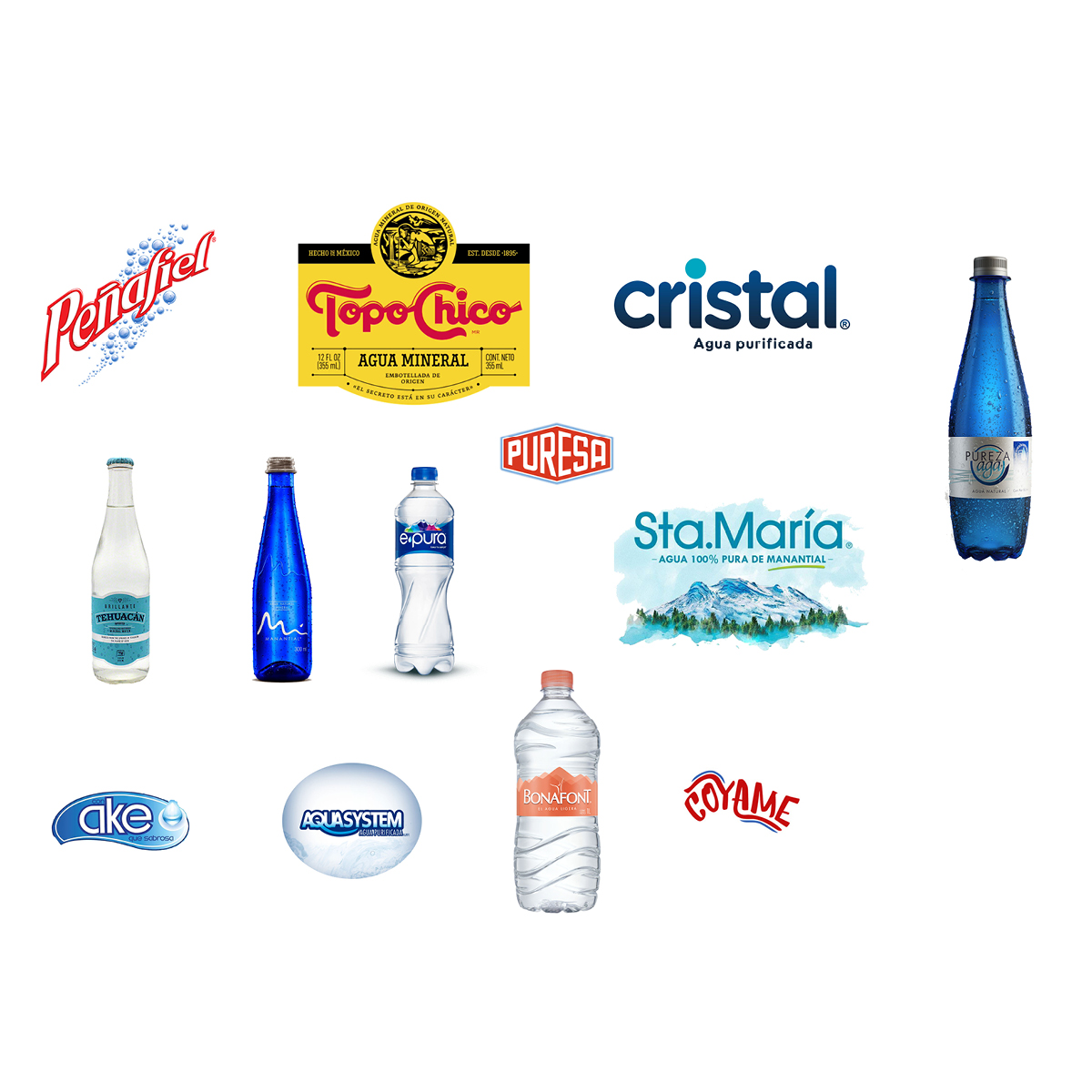
There are almost 6,000 bottled water manufacturers in Mexico, with 10 large consortiums, 150 large companies, 300 medium companies, 600 small companies, and 5,000 micro-companies in the mix. On top of that, almost 85% of bottled water in Mexico comes from micro bottlers using purified water. However, the trend of premium waters from natural sources has recently been gaining ground.1
The major bottled water companies in Mexico have established large scale networks regarding national distribution, sales support as well as promotional and advertising campaigns to showcase their brands, whereas the smaller ones operate mostly based on regional components in order to compete in more specific market segments. Regardless the excess of transportation and environmental impacts, the business of bottled water is going mad all-around Mexico and the liquid assets are highly valued. Interestingly enough, almost every one of the larger companies and several smaller ones as well, rebranded their products and profile in the past two years.
The case of Penafiel’s branding, probably the most ubiquitous mineral water in Mexico, is exemplary. “A thick, crystalline, slightly-salty water”, drawn from Citlaltépetl since 1928. Peñafiel’s water is actually the most mineral-heavy out of all the major mineral waters, clocking in at 880 ppm total dissolved solids! Compare that with Topo Chico’s 630 ppm, or even San Pellegrino’s 860 ppm. It’s also got almost three times the Sodium and twice as much Chloride as Topo Chico, making this one of the saltiest (probably the saltiest) mineral water on the market.2 New entries, such as Tehuacán Brillante, with “natural chill and bubble quality not as aggressive as Topo Chico”3 are also moving towards the same direction, trying to claim their share on the market. Is bottled water becoming a thing again?
← Back to Lexicon
The major bottled water companies in Mexico have established large scale networks regarding national distribution, sales support as well as promotional and advertising campaigns to showcase their brands, whereas the smaller ones operate mostly based on regional components in order to compete in more specific market segments. Regardless the excess of transportation and environmental impacts, the business of bottled water is going mad all-around Mexico and the liquid assets are highly valued. Interestingly enough, almost every one of the larger companies and several smaller ones as well, rebranded their products and profile in the past two years.
The case of Penafiel’s branding, probably the most ubiquitous mineral water in Mexico, is exemplary. “A thick, crystalline, slightly-salty water”, drawn from Citlaltépetl since 1928. Peñafiel’s water is actually the most mineral-heavy out of all the major mineral waters, clocking in at 880 ppm total dissolved solids! Compare that with Topo Chico’s 630 ppm, or even San Pellegrino’s 860 ppm. It’s also got almost three times the Sodium and twice as much Chloride as Topo Chico, making this one of the saltiest (probably the saltiest) mineral water on the market.2 New entries, such as Tehuacán Brillante, with “natural chill and bubble quality not as aggressive as Topo Chico”3 are also moving towards the same direction, trying to claim their share on the market. Is bottled water becoming a thing again?
← Back to Lexicon
Mexico bottled water companies.
- http://www.finewaters.com/bottled-waters-of-the-world/mexico
- http://www.bottledwaterweb.com/bottlersdetail.do?k=63
-
https://thebubbleverse.com/review/brands/tehuacan/mineral-water-2
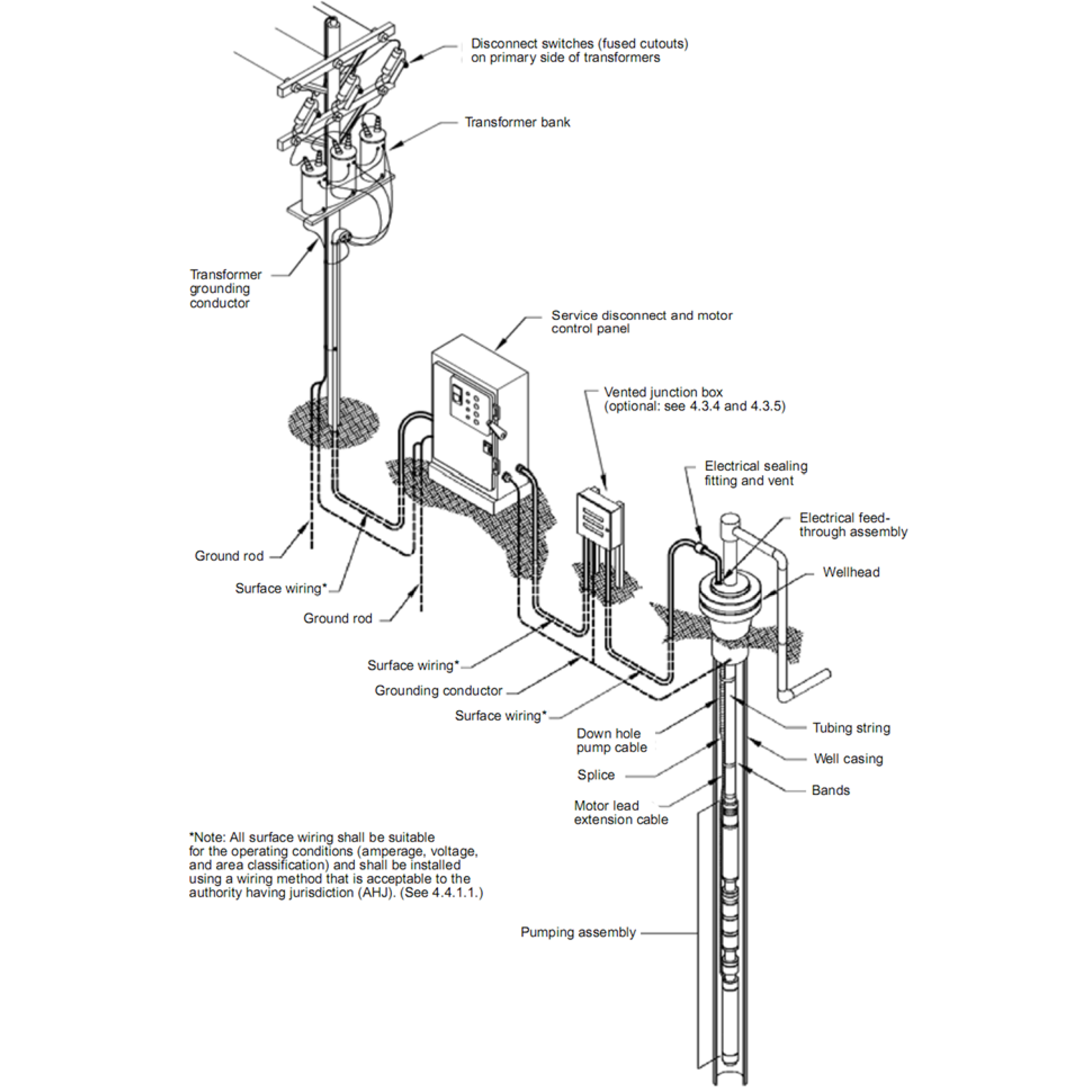
If you want to look for a machine that is responsible for the flooding and land subsidence in various cities, the submersible pump indeed is one of the tools which is contributing to the exploitation of groundwater extraction for drinking and irrigation.
Extracting water from the aquifers is not a bad thing. Wells was invented to get access to clean water, especially for areas that have no access to proper and clean surface water. Groundwater extraction can be safely extracted from the aquifer if it is balanced with the recharge rate through a natural or artificial process. Subsidence occurs when the water table in the aquifer is reduced from the rock that supports more weight when saturated (Overdrafting).
A contemporary submersible pump can extract up to 283 cubic meters of water/hour. meaning in one hour one of these types of pumps could provide daily water consumption for up to 900 people (300 liters/day). State of art submersible pump can be equipped with frequency drive operation to control the output of the pump. Therefore, it can extract the amount of water that the well could give and avoid over-pumping.
In Mexico City, a similar type of pump is used for water supply, six groundwater extraction wells collectively extracting almost 600 liters per second (around 300 cubic meters/hour/pump) and supply water to the entire municipality. Reliance on groundwater extraction to supply clean water for 20 million people has dropped water tables up to 35 meters in the last 40 years in some areas in Mexico City.
← Back to Lexicon
Components of an Electrical Submersible Pumping System.
Sources: Fetoui, Islam. “Submersible Pump System Overview: Main Surface and Downhole Components.” Production Technology, September 8, 2017. https://production-technology.org/submersible-pump-overview/.
Sources: Fetoui, Islam. “Submersible Pump System Overview: Main Surface and Downhole Components.” Production Technology, September 8, 2017. https://production-technology.org/submersible-pump-overview/.
- Kiley Fellow Lecture: Seth Denizen, "Thinking Through Soil: Case Study from the Mezquital Valley", YouTube Video, 1:14:58, “Harvard GSD,” September 22, 2020, https://www.youtube.com/watch?v=klJb9M-_3cg.
- The advantage of frequency drive operation in submersible pumps, Grundfos Video, 5:55, “Grundfos”, accessed May 2, 2020, https://www.grundfos.com/solutions/learn/ecademy/all-courses/the-sp-submersible-pump/the-advantages-of-frequency-drive-operation-in-submersible-pumps
- “Well.” Wikipedia. April 25, 2021. https://en.wikipedia.org/wiki/Well.